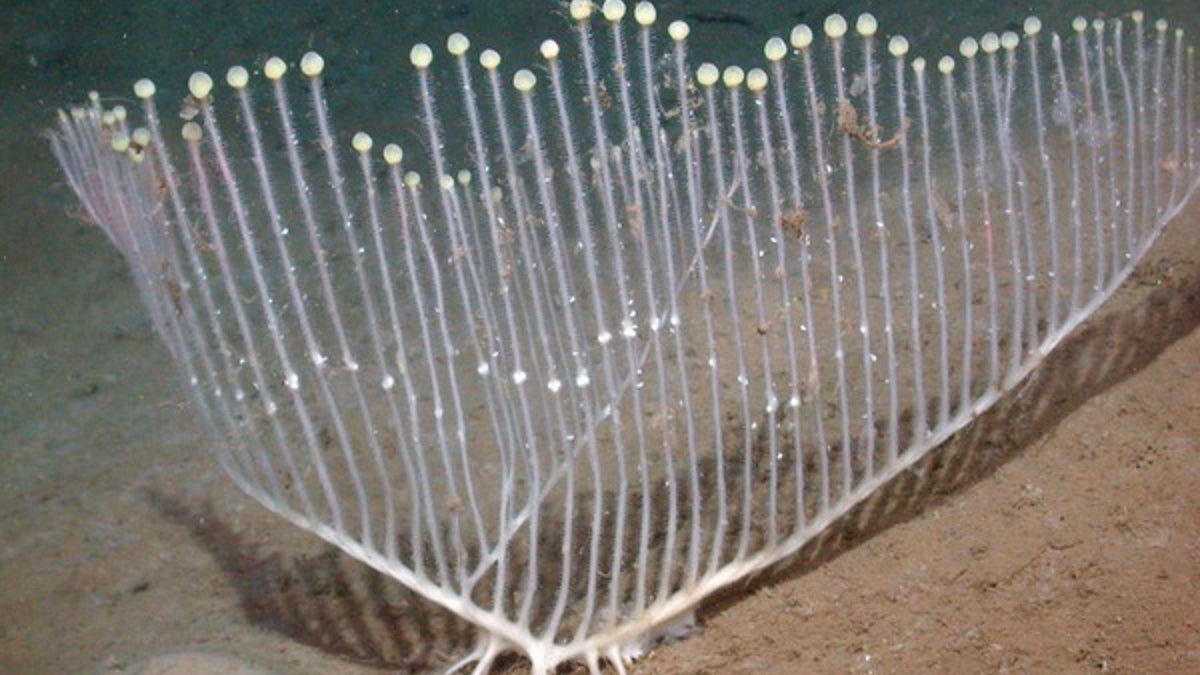
Vehicle = Tiburon Tiburon Dive# = 891 Lat= 40.98328400 Lon= -127.49394226 Depth= 3317.6 m Temp= 1.697 C Sal= 34.610 PSU Oxy= 2.14 ml/l Xmiss= 80.1% Source= digitalImages/Tiburon/2005/tibr891/DSCN5203.JPG Epoch seconds= 1125419308 Beta timecode= 01:11:02:18 (Copyright 2005 Monterey Bay Aquarium Research Institute)
A new carnivore shaped like a candelabra has been spotted in deep ocean waters off California's Monterey Bay.
The meat-eating species was dubbed the "harp sponge," so-called because its structure resembles a harp or lyre turned on its side.
[pullquote]
A team from the Monterey Bay Research Aquarium Institute in Moss Landing, Calif., discovered the sponge in 2000 while exploring with a remotely operated vehicle. The sponges live nearly 2 miles beneath the ocean's surface.
"We were just amazed. No one had ever seen this animal with their own eyes before," said Lonny Lundsten, an invertebrate biologist at the research institute and one of the first to see the harp sponge. [The World's Freakiest Looking Animals]
Researchers later collected two sponges and made video observations of 10 more. Comparison with other carnivorous sponges confirmed that Chondrocladia lyra, the sponge's scientific name, was a new species and revealed some interesting insights into the sponge's life cycle. The results of the analysis were published Oct. 18 in the journal Invertebrate Biology.
Catching a meal
Velcro-like barbed hooks cover the sponge's branching limbs, snaring crustaceans as they are swept into its branches by deep-sea currents.Once the harp sponge has its meal, it envelops the animal in a thin membrane, and then slowly begins to digest its prey.
The sponges cling to soft, muddy sediment on the ocean floor with root-like "rhizoids," living among other mysterious creatures. The first harp sponges scientists found had only two branches, called vanes. Additional remote-vehicle dives revealed creatures with up to six vanes, Lundsten told OurAmazingPlanet. The biggest were 14 inches (36 centimeters) tall. The team believes the harp sponge evolved this elaborate, candelabra-like structure to increase the surface area it exposes to currents so it can capture more prey.
The harp sponge is one of four new species Lundsten has helped identify. "We've seen only 1 percent of Monterey Bay and it's still one of the most well-studied regions of Earth in deep water," he said. "I can look out over the waters from MBARI and imagine thousands of species out there yet to be discovered."
Sponge sex
Scientists first discovered sponges can be carnivores less than 20 years ago. Most live in the deep ocean, which makes it difficult to fully understand their lifestyle.
The harp sponges collected by MBARI scientists mark the first time researchers observed the complete cycle of a carnivorous sponge's unique approach to sexual reproduction.
Most sponges release actively swimming sperm into the surrounding seawater, but it appears that all carnivorous sponges transfer sperm in condensed packages (spermatophores), the researchers report.
The swollen balls at the tip of the harp sponge's upright branches hold the sperm packets. The balls release the spermatophores into passing currents, and other nearby sponges capture the packets on fine filaments along their branches. The sperm then works its way from the packets into the host sponge to fertilize its eggs, according to the research scientists.
Images: 17 Amazing Sea Creatures You've Never Heard Of
Gallery: Bizarre Creatures from the Census of Marine Life
Strangest Places Where Life Is Found on Earth
Copyright 2012 OurAmazingPlanet, a TechMediaNetwork company. All rights reserved. This material may not be published, broadcast, rewritten or redistributed.
